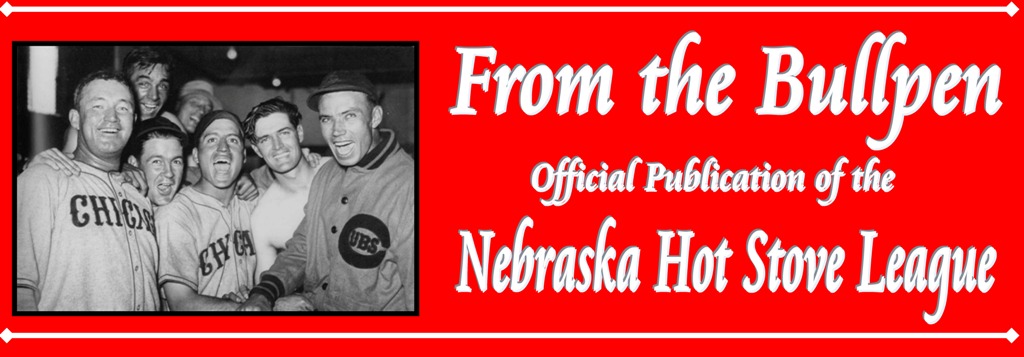

|
____________________________________________________________________________________
|
|
2010 Season |
Edition No. 8 |
March 4, 2010 |
|
____________________________________________________________________________________ |
||
|
Brethren:
I will scribble a few notes on my Tuesday night flight back from Orange County and see if we can’t produce something resembling an issue of From the Bullpen when everything is said and done.
On the first leg of my return trip from John Wayne Airport to Phoenix, I sat next to a nice guy (Jeff Odekirk) who develops Little League baseball complexes that are built to resemble historic major league ballparks such as Fenway, Wrigley, Ebbets Field, the Polo Grounds, and the like. He saw that I was reading my book about Chief Bender, asked me if I was a baseball fan or just a fan of Chippewa Indians in general, and we were soon engaged in a Shamu-and-total-stranger-like conversation. Turns out when Odekirk was a kid, he was a batboy for the LA Dodgers of Garvey-Lopes-Russell-Cey fame, and became a huge Bill Russell fan. Russell now does work for his company (Big League Dreams USA, LLC), helping to close ballpark development deals with local politicians and businessmen who knew his name from the Dodger heyday.
Odekirk said that one of his life’s great moments was when they had a big press conference to open up a new facility that features a replica of the old Polo Grounds, and they brought in Bobby “The Staten Island Scot” Thompson and Ralph Branca (of “The Shot Heard Round the World” fame) for the event. He said he sat right between the two of them, and got to hear Thompson say that it felt like he was back at the Polo Grounds again. Pretty cool story. Anyway, his website is www.bigleaguedreams.com for anyone who wants to take a look at what they do.
Chief Bender’s Burden
My overall assessment of this book is that it is an earnest attempt by a neophyte author to make the case that Charles “Chief” Bender was worthy of the baseball Hall of Fame because of his struggles against prejudice, as much as for his statistics, which seem marginal compared to qualifications of modern starting pitchers who are under consideration for the Hall of Fame. Swift’s book begins with Chief Bender’s preparations to pitch the opening game of the 1914 World Series between the powerful Philadelphia Athletics of Connie Mack and the “Miracle” Boston Braves, who were in last place in the National League in early July 1914, fifteen games behind the powerful New York Giants of Mugsy McGraw. On July 15 of that season, the Braves were in last place with a record of 33-43, while McGraw’s Giants appeared to be cruising to a fourth straight NL pennant. However, the Braves caught fire in the second half of the season, and ended up winning the National League pennant over the Giants by a whopping 10-1/2 games. They then boldly thumped the powerful Mack Men in the 1914 Series, beating the theretofore almost invincible Chief Bender in the first game of the Series and rolling on to an unthinkable 4-0 Series sweep.
While Bender’s Burden provides some great information about the powerful Athletics in the first two decades of the last century and the general state of things in the dead ball era, Swift’s prose often jumps around from year to year in such a way as to be distracting, and it is often hard to follow which season and which team he is talking about. Unlike most of the books I have reviewed in From the Bullpen, I cannot heartily recommend this one to you. Rather, allow me just to share with you a few of the interesting revelations:
So now you know the story of Chief Bender’s Burden.
I had a great trip to California on Monday and Tuesday, staying at a terrific resort in Huntington Beach. After my deposition on Monday afternoon, I had dinner and a few cold ones at “Duke’s” Restaurant on Huntington Beach, named after the iconic king of Southern California surfing. The next morning, I got up early for a walk along the beach, and was fascinated to see 60 or 70 surfers trying to catch waves on a Tuesday morning in March.
After a fantastic breakfast at the Sugar Shack, I made my way back to my hotel to bag a few rays in the 75-degree weather before having to catch my flight back to Omaha and its two feet of snow still on the ground.
Remind me again why my parents moved from Southern California back to the Midwest in 1957 instead of giving me the chance to explore my true calling as a surfer? Oh, well. Home is home, wherever you end up.
* * * * * *
As I put the finishing touches on this week’s edition of From the Bullpen, Draft Day is precisely 30 days away. If you are like me, you can hardly wait.
Have a great rest of the week.
Skipper
|